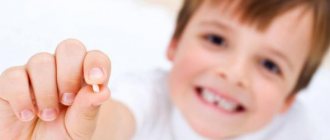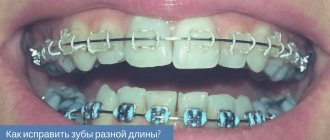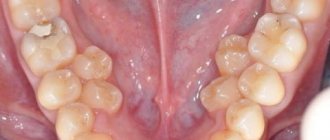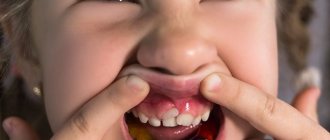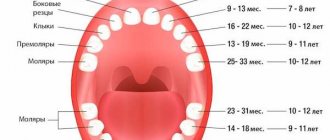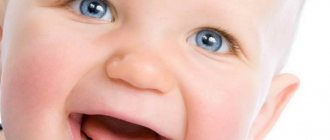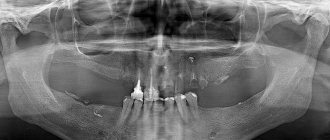Parents are always interested in the healthy development of their child. If for some reason any pathological changes occur in the baby’s health, adults are interested in eliminating the problems that arise.
Sometimes a warning sign is that a child has not lost his baby teeth for too long . To understand what to do, you need to know the process of formation of oral bone tissue, the time intervals for changing teeth, and the reasons that influence the duration of the change from baby teeth to permanent ones.
Features of changing temporary teeth to permanent ones
There are only 20 teeth in the primary dentition, although adults have from 28 to 32 (if all third molars have erupted). This significant difference is due to the structure and anatomical features of the child’s body. At a young age, the jaw is small; there is simply not enough space for so many teeth. However, as you grow older and with normal functioning of the body, the jaw grows and lengthens. This means that during the period of change in the child’s bite, not only 20 units must erupt, replacing the temporary ones, but also 8 new permanent ones, which have no milk analogues.
There are no premolars in a child's bite, so they immediately grow permanent. As the maxillofacial apparatus develops, they replace the primary molars. Total 2 pieces on the right and left on the upper and lower jaw.
Helping with the growth of permanent teeth
Late loss of primary teeth can be accelerated using various methods:
- In order for permanent teeth to begin to form and grow healthy, you should be attentive to oral hygiene from the very birth of the baby;
- Saturating the child’s body with a full complex of vitamins will eliminate the lack of calcium and other microelements necessary for the development of bone tissue;
- If the baby has jaw injuries, it is necessary to seek medical help to eliminate the inflammatory process of the gums;
- If the process of changing teeth occurs at a slow pace, you should visit a dentist who will identify the individual characteristics of the body (perhaps this is normal, or medical intervention is required).
The protracted process of changing the bone tissue of the oral cavity should not be ignored. Parents are advised to closely monitor any changes in the baby's condition. Timely elimination of developing pathologies allows you to get rid of possible problems in adulthood.
Purpose of milk bite
If the baby is not yet 6–7 years old, then there is no point in wondering why the child’s baby tooth does not fall out. On the contrary, this is good, because... temporary units are the custodians of space for permanent ones. If they fall out prematurely, this can lead to malocclusion and serious problems in the future.
So, if the milk element falls out long before the permanent one is ready to emerge, its neighbors may move and take up space, as a result, the permanent one will have nowhere to stand, it will begin to bend, and may change the direction of growth. The result of this process is impaired functionality of the maxillofacial apparatus, crooked or crowded teeth, an unattractive smile, problems with chewing food, the development of dental diseases, and, finally, early loss of permanent teeth.
On a note! Primary crowns have the same shape as permanent crowns. However, they are much smaller in size, also have shorter roots and a short service life. Their roots begin to dissolve just a few years after they are fully formed.
How it all happens
First of all, a little anatomy. Baby teeth are formed in the prenatal period, but the formation of permanent teeth begins after the baby is born. Thus, when you rejoice at the first tooth that has erupted, its replacement is already waiting in the wings. The time and order of eruption of permanent teeth, as well as milk teeth, is individual for each child. But temporary teeth fall out in approximately the same order as they appeared. The permanent first molars appear first. There is no milk analogue for these teeth, because in a small child’s jaw there was simply not enough space for them. The baby grows, the gaps in the dentition increase and the first adult teeth appear in the mouth - the so-called “sixes”. After the molars have erupted, it is time to replace the baby teeth with permanent ones. Loss occurs, as a rule, in the same order as appearance.
When does the milk bite begin to change?
The average age of a child who begins to change their bite is 6–7 years. The deadline is 8 years. True, doctors note that there is a tendency that today the process of change begins in children and at an earlier period - at 4-5 years. And situations arise much less often when this happens later than average. However, in any case, you shouldn’t panic right away; you need to take into account individual characteristics and a number of factors, which we will definitely talk about below.
The replacement process ends at the age of 14–16 years.
Causes of tooth loss
In most cases, the process of replacing temporary teeth with permanent ones occurs quite unnoticeably. The molar simply pushes out the milk tooth and pecks in its place. In some cases, dangerous disturbances may develop, in which permanent elements begin to grow in close proximity to temporary ones. If such changes are detected, you should immediately contact a specialist.
Disturbances in the growth process may be associated with the individual characteristics of the development of the individual child’s body. Incisors and molars may not appear due to disorders associated with improper formation of tooth buds.
The timing of tooth loss in a child, as well as their appearance, can be determined individually. And before removing an untimely fallen tooth, it is mandatory to take an x-ray. This examination method will reveal the presence or absence of a rudiment in the gum. If it is not there, the baby tooth should not be removed; it can serve the person for some time.
The reason for the delay in the loss of primary teeth may also be due to the removal of nerves in the roots of primary teeth in the past. In the process of treating pulpitis, only part of the pulp located in the crown is removed. In order to influence the remaining part of the pulp, a special medicinal composition is applied under a permanent filling. In such cases, only forced removal will help restore the natural process.
Timing for changing temporary units to permanent ones
The process of resorption of temporary roots lasts approximately 2–3 years. Its stimulation begins the moment the root comes into contact with the crown of the permanent unit. When the resorption process reaches the neck, the tooth should already begin to wobble and calmly fall out. After which permanent growth appears almost immediately in the vacant space; full growth will appear over the next 3–4 months.
The process of resorption of the milky root begins for each element of the series at a different period:
- for anterior incisors at 5 years: i.e. Their loss should occur at about 7 years of age,
- for lateral incisors at 6 years old,
- for first molars at 7 years old,
- for fangs at 8 years old,
- for second molars at 7 years of age: their roots take the longest to resolve, and fall out only by 11–14 years of age.
The process proceeds symmetrically, i.e. the roots of the same types of teeth on the upper and lower jaws, their left and right halves, resolve and fall out at approximately the same time.
When do permanent teeth emerge?
Children grow very quickly, and the exciting process of the appearance of the first tooth is replaced by the next, sometimes no less restless – the replacement of temporary teeth with permanent ones. The order of their elimination often coincides with the frequency of their pecking, with the exception of the fangs - their replacement often occurs later.
The germination pattern of new elements of the series is presented in the list:
- lower and upper incisors appear by 7-8 years,
- lateral incisors should hatch by 8-9 years of age,
- the upper lateral incisors appear by age 9,
- lower canines appear by 10 years of age,
- premolars appear before the age of 12 years,
- upper premolars and canines appear at the age of 13 years,
- lower and upper second molars appear between 11 and 13 years of age.
It is also worth paying attention to the fact that third molars or so-called wisdom teeth appear in adulthood and not for everyone. Their appearance is the most painful process, which occurs between 18-25 years. These elements do not last long, are not subject to therapeutic treatment and are removed immediately after germination or destruction.
Reasons why baby teeth don't fall out
Now let's talk about why baby teeth don't fall out for a long time.
1. The rudiments of the permanent unit are deep in the gum
In this case, they can grow longer than the average period indicated by doctors, which is associated with the individual physiological and anatomical characteristics of the child. Here the dentist evaluates the clinical picture and suggests either waiting or pulling out the “stagnant” element using special tools.
The temporary root does not resolve
Doctors again do not associate this disorder with a pathological process. This happens due to the physiological characteristics of the child. However, if new teeth grow, but baby teeth do not fall out due to the fact that the process of resorption of their roots is disrupted, then this is fraught with the eruption of permanent units in an atypical place for them. And, as a result, malocclusion. To prevent this, the doctor decides to remove it. The child may also need to correct the bite later using plates or braces.
“My daughter has a tooth erupted on the right side of her upper jaw, but her baby canine has not fallen out. On the left side the situation is similar - the canine has not fallen out yet, but the molar is growing. Visually it looks ugly, because... New fangs have appeared literally on top of the old ones, and they are located in two rows. We immediately went to the dentist to somehow correct the situation. Naturally, an extraction was scheduled, and now we still have to wear an orthodontic device to normalize the bite.”
Lyudmila Ageeva, review from woman.ru
The rudiments of permanent teeth are damaged
The rudiments can be damaged or die due to periodontitis, pulpitis, and deep caries in the primary occlusion. This situation is also true for children who have suffered osteomyelitis of the jaw or who have received injuries to the maxillofacial apparatus.
On a note! A delayed change in bite may be associated with rickets1, vitamin deficiency, diet, climatic conditions, lack of calcium and fluorine in the body, which slows down the process of formation and growth of permanent units.
If the rudiment is damaged, several scenarios are possible: either the tooth will not erupt at all, or it will erupt with a delay and some kind of pathology (for example, hypoplasia).
The rudiments are located incorrectly in the bone
If the rudiment of a permanent unit does not rush to break out at the appointed time, then it is possible that it simply occupies the wrong position in the jaw bone. This anomaly is called “dystopia”. Depending on the situation, your doctor may suggest pulling the crown into place using surgical and/or orthodontic treatment. If this is not possible, then the condition of such a tooth must be monitored over time: if it threatens the health and integrity of neighboring units and tissues, it will have to be removed surgically.
On a note! Doctors also distinguish such a concept as “retention,” which sometimes happens with permanent elements that are in no hurry to replace milk ones. With this pathology, they are either completely under the mucosa or partially break out. To solve the problem, in some cases, dissection of the gums is sufficient; sometimes the use of orthodontic appliances or a set of measures aimed at normal tooth growth is required.
The rudiments are completely absent
This anomaly can occur due to the fact that the child’s mother was exposed to various diseases during pregnancy, led an unhealthy lifestyle and had bad habits. Or the baby himself suffered a serious infectious or viral disease at an early age. Also, the absence of rudiments may be associated with a hereditary factor or with the presence of congenital anomalies in the development of the maxillofacial apparatus in the child, or with metabolic disorders.
Most often, in this situation, the roots of the milk units gradually dissolve under the influence of the buds of neighboring teeth. However, it also happens that this does not happen, and then a person has a chance to save a child’s tooth until adulthood. Otherwise, you will have to deal with adentia and think about prosthetics or implantation (the second option is possible only after 18 years).
Delay in loss of primary teeth
Your child is finishing school, but some of his baby teeth have not yet been replaced by permanent ones? It is worth making an appointment at a dental clinic. Temporary teeth that remain in their places for too long are a sign that there are disturbances in the functioning of the child’s body.
Late tooth loss can be caused by:
- abnormal location of the permanent tooth germ;
- regular stress;
- malnutrition and lack of vitamins and microelements;
- chronic diseases.
Do you want your child to have straight and healthy permanent teeth? Do not neglect preventive examinations at the dentist twice a year.
Shark teeth: what do they have to do with changing the bite?
There is an anomaly that doctors call “shark teeth”. This is exactly the situation when a permanent tooth has grown, but the milk tooth has not fallen out. As a result, they are not located in the same row, but parallel to each other. Sometimes it happens that the temporary unit falls out on its own within three months, but if this does not happen, then you need to go to the doctor to remove it.
The consequence of this deviation is malocclusion. To prevent a child from having problems as an adult, it is necessary to correct the situation by wearing mouthguards, trainers or braces.
Causes and symptoms
A child's baby teeth fall out to make room for molars. That is, after a certain time, a permanent tooth will erupt in the place where the baby tooth was. A sign of prolapse will be two symptoms. Increased interdental spaces and loosening of the teeth themselves. The first indicator is associated with the growth of the child’s jaw, and the second is a marker of root resorption. Having lost its base, the milk jug gradually becomes loose and falls out. All processes before the loss and the loss itself are painless, and the child does not feel much discomfort.
The absence of interdental spaces is not considered a serious deviation, but parents are still advised to show their child to a pediatric dentist. But the absence of the main sign at the scheduled time before loss, loosening, can ultimately lead to certain problems.
All the difficulties that a child will encounter regarding non-loss of teeth will be associated with the reason why the loss itself occurs, that is, with the growth of permanent teeth. Permanent units will begin to grow next to the temporary ones, leading to discomfort, and quite possibly to problems that will have to be solved dentally.
Do you feel nervous before visiting the dentist?YesNo
If the cause of non-loss is the asymmetry of tooth loss or too early growth of the molars, then everything should end without significant complications. If the milk jugs remain in place as a result of the lack of rudiments of growth of permanent units, then parents can expect serious abnormalities in their child.
What can result from untimely change of primary occlusion?
The main problem is the curvature and deformation of permanent teeth, as well as a violation of the bite and functionality of the maxillofacial apparatus. This, in turn, will affect the child’s health and the beauty of his smile. However, parents should not panic, because the main thing is to see a doctor on time and not delay treatment.
Even if the problem is permanent, but the milk element has not yet fallen out, then this situation can be solved. The child will simply be prescribed orthodontic treatment later. Remember that in childhood, malocclusion pathologies are corrected more easily and quickly than in adults.
In the absence of rudiments and edentia, one of the prosthetic options is selected, which corresponds to the age and individual characteristics of the child.
When do children's baby teeth start to fall out?
Temporary elements of the dentition fall out after the process of formation of molars in the gums is completed. This process is completed by age 8. However, all the deadlines defined for such a process are extremely relative and it is simply not possible to name the exact time. The process of eruption of indigenous elements is influenced by the characteristics of the body and gender. Temporary elements fall out earlier in boys than in girls. If the tooth does not fall out within the specified time frame, there is no need to rush things; such an issue requires qualified help only in extreme cases.
To read: Inflammation of the palate
Delays in eruption may be associated with environmental factors, the child’s immunity and the region of his residence. Parents should not worry; most often, a child has a full set of teeth by the age of 14.
It is worth noting that early tooth loss, on the contrary, should worry parents and become a reason to visit a dentist.
The approximate timing of tooth loss is determined depending on the order of their germination:
- at the age of 5-6 years, the incisors located on the lower and upper gums fall out,
- between 6 and 8 years, the lateral incisors are lost,
- at 8-10 years old the child loses his first molars,
- at the age of 9-11 years, fangs are lost,
- Before the age of 13, the second molars fall out.
This plan is quite relative and you should not look for pathology where there is none. The timing may vary by up to 4 years, meaning the loss of the first tooth may occur at 9-10 years of age. The reason to consult a doctor is the growth of the root element until the milk element is eliminated. You also need to consult a doctor if the row replacement process has not begun before 10 years.
In some cases, the dentition with temporary teeth remains intact due to the absence of molars. In this case, the elements are not removed because they can last for a long time. With such teeth, if treated in a timely manner and provided with the necessary care, a person can live up to 40 years. After the row is destroyed, implantation is carried out.
What to do with a baby tooth if there are no rudiments of a permanent tooth
If such a problem was identified by a dentist, the doctor will act based on the clinical situation:
- if there are no rudiments, but the temporary unit stands firmly and does not wobble, and the process of root resorption has not begun, then removal is not advisable: on the contrary, you need to try to preserve it as long as possible. Because A “milk” crown is smaller than a permanent one, then to give an aesthetically pleasing smile, prosthetics can be done with veneers or lumineers,
- if the milky root is mobile (grade 3–4), it is removed: prosthetics will further help to avoid problems with bite. After 18 years, you can resort to implantation.
Guide to action for parents when changing their bite
Have you noticed that your milk units are wobbly or have already started to fall out? Explain to the child that during this period there is no need to touch the gums and loosen the teeth even more, much less disturb them with various objects, because this can lead to injury (for example, the crown and root will crumble, and fragments will remain in the gum) or the introduction of infection into the oral cavity from the outside.
What is prohibited?
During the period of row change it is prohibited:
- eat colorful foods,
- eat candy and other sweets,
- loosen the tooth in place,
- carry out removal at home,
- touch the wound with your hands or any objects - there is a risk of infection,
- treat the wound with substances containing alcohol,
- eat foods that can irritate the mucous membranes: sour, salty, spicy, hot and cold drinks,
- eat immediately after tooth loss - the minimum interval before eating is 2-3 hours.
Following these recommendations will ensure a painless process.
What to do when a tooth falls out naturally
- Prepare a weak soda solution for your baby to disinfect the resulting wound,
- to stop bleeding from the hole, apply a small piece of cotton wool or bandage to it: the child should bite it lightly and hold it for about 5 minutes,
- do not feed the baby within two hours after the loss,
- for a day, exclude spicy, salty, sour and anything that can irritate the resulting wound from your diet,
- Don’t forget to support your child’s faith in miracles: be sure to tell about the fairy who will exchange a baby tooth for a gift or a pretty penny.
What should parents do?
Losing primary teeth is a completely natural process and most often it is not accompanied by pain or complications. Nevertheless, in order to be sure of the baby’s health, you should follow a few simple rules:
- The teeth should fall out on their own. Do not pull out a tooth that has begun to loosen - you may accidentally damage a root that has not yet completely resolved and it will remain in the gum. You can help a tooth only if it really “hangs by one thread.” It’s even better if the tooth is removed by a pediatric dentist;
- After a tooth falls out, the wound may bleed. Give your baby a sterile gauze swab and ask him to bite down firmly - the bleeding will stop in a few minutes. Try not to feed your child for a couple of hours after losing a tooth. For the same period, you should give up hot, sour and salty foods;
- When changing teeth, it is very important to visit the dentist once every six months for preventive examinations. Your doctor will assess the general condition of your teeth and give recommendations on how to care for your baby and permanent teeth;
- Even though baby teeth are temporary, their condition must be treated very carefully. The health of temporary teeth directly affects the health of permanent teeth.
With each new permanent tooth, your child becomes more mature. Attentive attention to oral hygiene and regular dental checkups can give your child one of the main decorations: a healthy and beautiful smile.




